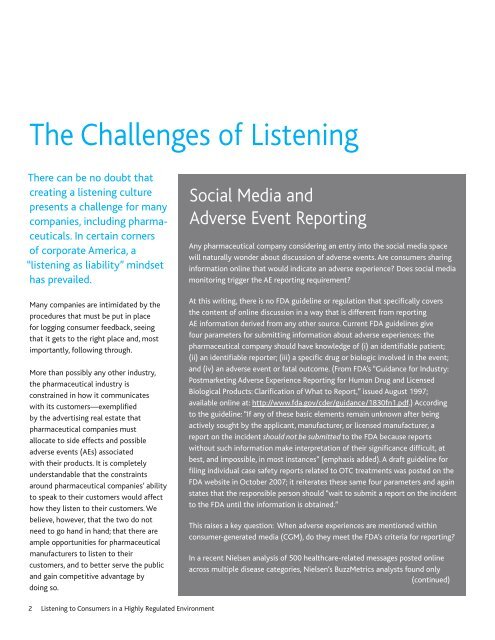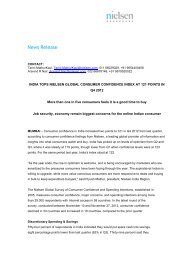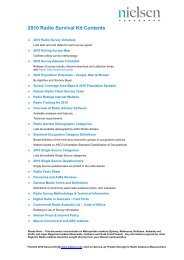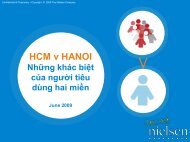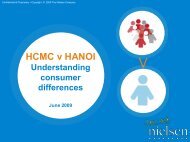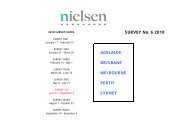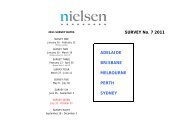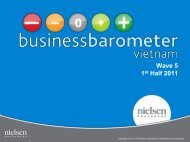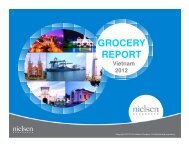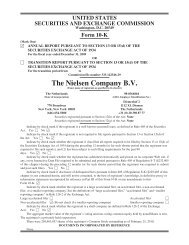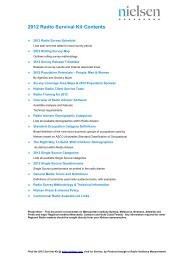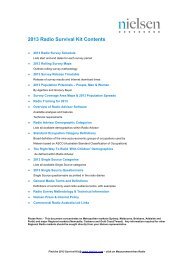Listening to Consumers in a Highly Regulated Environment - Nielsen
Listening to Consumers in a Highly Regulated Environment - Nielsen
Listening to Consumers in a Highly Regulated Environment - Nielsen
Create successful ePaper yourself
Turn your PDF publications into a flip-book with our unique Google optimized e-Paper software.
The Challenges of <strong>Listen<strong>in</strong>g</strong><br />
There can be no doubt that<br />
creat<strong>in</strong>g a listen<strong>in</strong>g culture<br />
presents a challenge for many<br />
companies, <strong>in</strong>clud<strong>in</strong>g pharmaceuticals.<br />
In certa<strong>in</strong> corners<br />
of corporate America, a<br />
“listen<strong>in</strong>g as liability” m<strong>in</strong>dset<br />
has prevailed.<br />
Many companies are <strong>in</strong>timidated by the<br />
procedures that must be put <strong>in</strong> place<br />
for logg<strong>in</strong>g consumer feedback, see<strong>in</strong>g<br />
that it gets <strong>to</strong> the right place and, most<br />
importantly, follow<strong>in</strong>g through.<br />
More than possibly any other <strong>in</strong>dustry,<br />
the pharmaceutical <strong>in</strong>dustry is<br />
constra<strong>in</strong>ed <strong>in</strong> how it communicates<br />
with its cus<strong>to</strong>mers—exemplified<br />
by the advertis<strong>in</strong>g real estate that<br />
pharmaceutical companies must<br />
allocate <strong>to</strong> side effects and possible<br />
adverse events (AEs) associated<br />
with their products. It is completely<br />
understandable that the constra<strong>in</strong>ts<br />
around pharmaceutical companies’ ability<br />
<strong>to</strong> speak <strong>to</strong> their cus<strong>to</strong>mers would affect<br />
how they listen <strong>to</strong> their cus<strong>to</strong>mers. We<br />
believe, however, that the two do not<br />
need <strong>to</strong> go hand <strong>in</strong> hand; that there are<br />
ample opportunities for pharmaceutical<br />
manufacturers <strong>to</strong> listen <strong>to</strong> their<br />
cus<strong>to</strong>mers, and <strong>to</strong> better serve the public<br />
and ga<strong>in</strong> competitive advantage by<br />
do<strong>in</strong>g so.<br />
2 <strong>Listen<strong>in</strong>g</strong> <strong>to</strong> <strong>Consumers</strong> <strong>in</strong> a <strong>Highly</strong> <strong>Regulated</strong> <strong>Environment</strong><br />
Social Media and<br />
Adverse Event Report<strong>in</strong>g<br />
Any pharmaceutical company consider<strong>in</strong>g an entry <strong>in</strong><strong>to</strong> the social media space<br />
will naturally wonder about discussion of adverse events. Are consumers shar<strong>in</strong>g<br />
<strong>in</strong>formation onl<strong>in</strong>e that would <strong>in</strong>dicate an adverse experience? Does social media<br />
moni<strong>to</strong>r<strong>in</strong>g trigger the AE report<strong>in</strong>g requirement?<br />
At this writ<strong>in</strong>g, there is no FDA guidel<strong>in</strong>e or regulation that specifically covers<br />
the content of onl<strong>in</strong>e discussion <strong>in</strong> a way that is different from report<strong>in</strong>g<br />
AE <strong>in</strong>formation derived from any other source. Current FDA guidel<strong>in</strong>es give<br />
four parameters for submitt<strong>in</strong>g <strong>in</strong>formation about adverse experiences: the<br />
pharmaceutical company should have knowledge of (i) an identifiable patient;<br />
(ii) an identifiable reporter; (iii) a specific drug or biologic <strong>in</strong>volved <strong>in</strong> the event;<br />
and (iv) an adverse event or fatal outcome. (From FDA’s “Guidance for Industry:<br />
Postmarket<strong>in</strong>g Adverse Experience Report<strong>in</strong>g for Human Drug and Licensed<br />
Biological Products: Clarification of What <strong>to</strong> Report,” issued August 1997;<br />
available onl<strong>in</strong>e at: http://www.fda.gov/cder/guidance/1830fn1.pdf.) Accord<strong>in</strong>g<br />
<strong>to</strong> the guidel<strong>in</strong>e: “If any of these basic elements rema<strong>in</strong> unknown after be<strong>in</strong>g<br />
actively sought by the applicant, manufacturer, or licensed manufacturer, a<br />
report on the <strong>in</strong>cident should not be submitted <strong>to</strong> the FDA because reports<br />
without such <strong>in</strong>formation make <strong>in</strong>terpretation of their significance difficult, at<br />
best, and impossible, <strong>in</strong> most <strong>in</strong>stances” (emphasis added). A draft guidel<strong>in</strong>e for<br />
fil<strong>in</strong>g <strong>in</strong>dividual case safety reports related <strong>to</strong> OTC treatments was posted on the<br />
FDA website <strong>in</strong> Oc<strong>to</strong>ber 2007; it reiterates these same four parameters and aga<strong>in</strong><br />
states that the responsible person should “wait <strong>to</strong> submit a report on the <strong>in</strong>cident<br />
<strong>to</strong> the FDA until the <strong>in</strong>formation is obta<strong>in</strong>ed.”<br />
This raises a key question: When adverse experiences are mentioned with<strong>in</strong><br />
consumer-generated media (CGM), do they meet the FDA’s criteria for report<strong>in</strong>g?<br />
In a recent <strong>Nielsen</strong> analysis of 500 healthcare-related messages posted onl<strong>in</strong>e<br />
across multiple disease categories, <strong>Nielsen</strong>’s BuzzMetrics analysts found only<br />
(cont<strong>in</strong>ued)


